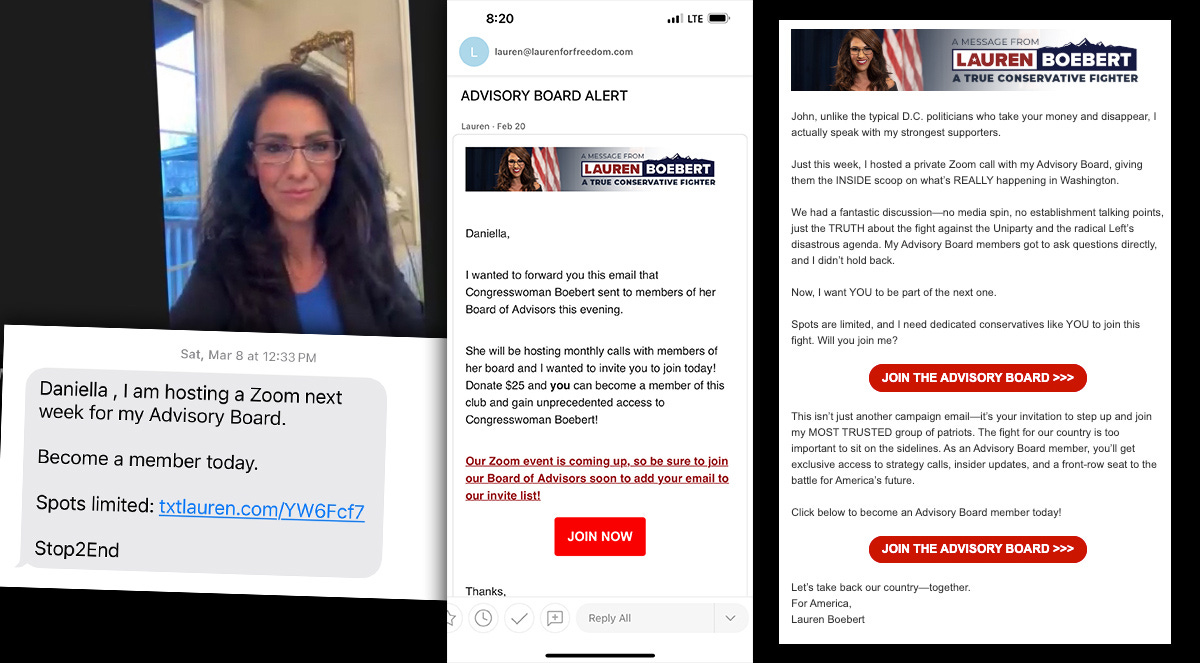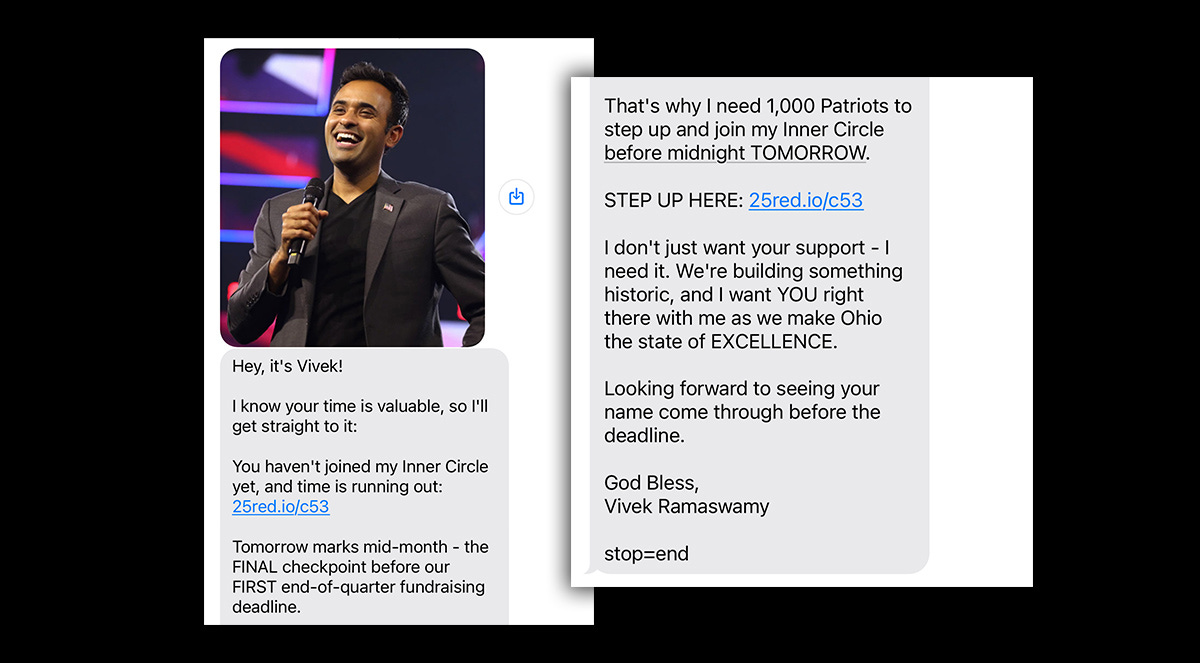Hello. Welcome to another edition of Doomscroll, your favorite newsletter covering all things digital on the right, and where everything’s computer. We know why we have assembled so let’s get to it!
One Question
Thanks to everyone who answered last week’s One Question about who will become the Democratic Party’s savior. Y'all…I don’t think I’ve ever seen poll results this split. We are all over the place. Gavin Newsom got 22% of the vote, as did “someone who isn’t even on the national scene yet.” Everyone else is basically equally split between Dean Phillips, Josh Shapiro, Jared Polis and Andy Beshear. One person wrote in Dwayne Johnson (just an ordinary demi-guy!), and I’m not mad about that. Here are some more comments:
I’m enjoying the show.
I think Dems SHOULD go to Jared. CO is one of the few blue states people are moving to. It's a low bar, but Polis is one of few Democrat leaders not ideologically opposed to capitalism. He's a gay man that has certainly pushed social issues from the left but hasn't made the culture wars a defining feature of his administration as other dems. He's pushing some housing reforms that are actually market-based. He reads more as a moderate than he actually is, and I think that will be attractive to independents. Now will they actually go that direction? Maybe not.
There's a lot of different issues that have added up over time. First, they refuse to criticize their own. When a portion of your "base" is pushing "defund the police", you need to start saying "no we don't stand for this". It's only gotten progressively worse in terms of policies since.
Second, as Carville put it, they have a "majoritarian" philosophy - i.e. whatever it takes to get another vote, they'll go after. The problem is that's become an increasingly smaller and more insular audience. After all, how many trans-disabled Palestinian drag queens in wheel chairs are there to appeal to? A lot of other people see the messaging as well courtesy of social media.
Third, their entire non-profit complex always needs another issue to sustain itself. As Tucker explained HRC didn't celebrate the Supreme Court legalizing gay marriage since they were out of business if they didn't find something else (hence pushing the trans stuff right after). Same story with the environment. Over time, it keeps pushing their issues to the extremes.
Fourth, corporate America and their HR departments aligned so much with the worst elements of the party that they created a long-term backlash. See all of the major Fortune 500 companies violating the Civil Rights Act putting out/celebrating how they weren't hiring white men. Everyone knew which side of the aisle agreed with that. A special shoutout to Hollywood for destroying every franchise invented prior to 2016 due to having similar political philosophies as the worst HR departments.
Finally, the party itself doesn't actually believe in anything other than gaining power. I had an interesting chat a few years back with a union organizer who tried to lobby on the hill. Virtually none of the Dems this person talked to knew what a union was. All they cared about was how much money they were being paid. The Sam Bankman-Fried bit with all the Dems taking photos with him demonstrate a lot closer how their elected generally operate on average. In sum, you have a party apparatus designed to gain power, but rotted over time by pushing increasingly insane positions that impacted too many people negatively that it couldn't be ignored. I have no clue where they go from here. It would take a donor larger than Soros coming in a basically buying them out to change them.
**One other thing: Someone submitted this question:
Other than Leadership Institute, where can conservatives find training?
I wish I knew! I assume we’re talking about training in the dark arts of digital? If anyone has some good suggestions, email them to me at itsthedoomscroll@gmail.com, and I’ll include them in next week’s edition!
This week’s One Question is about relational organizing. Before you roll your eyes and keep scrolling, humor me, will you? The Center for Campaign Innovation released a case study on it this week (more on that below - yay you!) and so it’s never been a better time to revisit the subject. What I want to know is this: Have you been persuaded that relational organizing works, but still doubt you’ll use it as a campaign tactic? If so, why? My gut tells me that’s where most of us are right now. Sure, we all know it works, but it’s too difficult to execute at scale so why spend precious resources on it? Is that right? Let me know! PLEASE AND THANK YOU.
One Quote
One Thought
The above quote comes from the complaint filed in the Northern District of Texas’ Fort Worth Division in Tony McDonald v. FEC. Personally, I hope this lawsuit is successful. Why should small-dollar donors be forced to have their contributions be made public? What’s more, success here means less data scraping by bad actors in our space. IYKYK.
Just a thought!
Who’s Doing What
—From one friend to another
Ok. Time to discuss this study that was put out this week by Eric Wilson and the Center for Campaign Innovation. Longtime Doomscroll readers know I have a bit of an obsession with relational organizing and the fact that Republicans just haven’t embraced it as a campaign tactic - despite the success we’ve seen it have on the left. Here’s where I am with it at the moment, and where I think this latest case study points us to: Relational Organizing works IF - and this is a big IF - you have the resources to scale it.
The biggest problem I see is the loooooooow conversion rate, which the study acknowledges. If you text 424,000(ish) people and only get 101 volunteers…that’s kind of a problem. Let’s say you spent somewhere in the neighborhood of $12,000 to send those P2P recruitment texts. That equals about $126 per recruit which is a tough number to justify to anyone, let alone campaigns short on cash. Is it worth the 8.6% lift - or the 150 extra votes? Maybe. But that’s not even counting how much the campaign is shelling out for the gift cards they promised (in this hypothetical scenario). I’m also a little puzzled by the study’s conclusion that P2P texting showed no measurable impact on turnout. I could be wrong, but I’m sure I’ve seen studies and examples that say otherwise.
Anyway, I’m on the fence over whether I find this study encouraging or discouraging. Yes, we’ve known for a while that relational organizing works (although it’s nice to see it confirmed on our side of the aisle). But now my biggest hang-up is the cost of doing business. For a major statewide campaign flush with cash, I still think it’s a no-brainer. For smaller races? It’s gonna be difficult to execute. Perhaps some enterprising campaign out there will experiment with shifting GOTV ad dollars from traditional digital campaigns towards relational organizing to drive turnout. I’d love to see it, but it’s going to take lots and lots of planning, which means starting early in the campaign cycle when we’re not usually thinking about GOTV. Some final thoughts:
I’d love to see a case study about the impact relational organizing has on the persuasion side. Are you more likely to view an entire ad if a friend sends it to you? Probs.
Perhaps one thing that’ll be hard to get around is GOP voters’ concerns around tech and privacy. Asking conservatives to share their address book is a HUGE ASK.
I get why they targeted low-propensity voters in this experiment, but maybe the simple reality is that people who don’t vote very often won’t care enough to download an app and tell other people to vote. It is what it is.
Wonder what would happen if you ran recruitment ads on social along with the P2P campaign.
One way to start early: As you’re building an email list, target these low propensity voters so you can also recruit down the road via email.
The report hints at this, but I kind of agree that offering gift cards may not be the best incentive. I’d think about testing a video message from the candidate. Maybe more expensive to send, but it’s more authentic.
—Flipping the Script
Lots of politicians use things like advisory boards, kitchen cabinets, and inner circles in fundraising copy to make donors feel more connected to the campaign. Very few - if any - follow through with any sort of next step. Enter Rep. Lauren Boebert. Now, whatever your feelings are on the Congresswoman from Colorado, you gotta admit this is a nice play. Boebert actually gave back to her Grassroots Advisory Board by hosting a private Zoom call with small-dollar online donors. According to someone who was on the call, Boebert discussed things like the CR and DOGE, took questions from the audience, and conducted live polls. I LOVE it. More of this!
—Not Ashamed
…to admit that this X account has had me LOL’ing all week.
Who’s Spending Where
P2P
This week’s text shout-out goes to Vivek Ramaswamy. I’ve gotten a number of good texts from his gubernatorial campaign since he launched it, but this one stood out. Good use of MMS, and the CTA isn’t over-the-top with the guilt/pressure. I like that it’s also tied to a fundraising deadline, which ups the urgency. My gut tells me this one probably performed very well! Nice.
Industry Watch
🏙️ Out of home advertising surpassed $9.1 billion last year - a 4.5% increase from the previous year.
👣 Digiday has a nice deep dive on attribution modeling and the WTF it even means.
🗣️Facebook now lets you use a “Chat with leads” feature when running lead-gen campaigns. Could come in handy!
👨👩👧👦 Google is now weighing in on age verification laws. The tech giant proposed a “legislative framework” that would require app stores to verify ages, but only share that information with products that “may be risky for minors.” Read more about it here.
💻 So…Reddit is the fastest-growing social media site? Guess so!
2025-2026 Watch
Can Paul LePage make a comeback in Maine? Looks like he might try.
Is the Trump-Tillis spat for real? Decide for yourself.
Don Jr. is backing Byron Donalds for governor of Florida. Shocker.
Charlotte O’Hara will run for Governor of Kansas. Read more.
Will Jim Tressel run for governor of Ohio? Would be a tough climb…(but don’t worry, Jim. It ain’t about how fast you get there…it’s the climb!)
Perhaps Scott Brown will run for Senate in New Hampshire? Gah!
Or maybe former NH Governor Chris Sununu will bite the bullet and run? Who knows!?
The Grapevine
Congrats to Lauren Dooley for joining National Media!
ICYMI: The AP covered how two GOP firms got some nice contracts from DHS without having to go through the normal bidding process… Read it here.
Alright, my friends: Have fun in Austin this week, and don’t do anything I wouldn’t do! JK, obviously. Do it all, and then send it to me for the Grapevine!
Ok, I have a nice little treat for everyone today. Many of you probably know Carl Sceusa; he recently joined IMGE as CEO, but has had a LONG career in the digital space. And because he’s a cool dude, he agreed to do a little Q&A sesh for us (you know how I love featuring smart people in our space!). Thanks, Carl!
First off: Who the heck are you?
Carl Sceusa - I’ve spent the last decade building tech and teams in the digital space. I got my start in a 2 person digital team at the NRSC (we were called New Media back then), was ¼ of the original team at IMGE, was CTO for a highly trafficked publisher, and then became one of the WinRed founders. I was a covid refugee to the Free State of Florida where I worked with Governor DeSantis and live with my wife, Mia.Congratulations on your new role at IMGE! We hear you’re on a mission to bring new tech and a focus on AI to the firm. Tell us more about that.
Thank you, I’m very excited to be back at IMGE in this new role. I worked very closely with the current team at IMGE in the last election cycle on a few big projects and couldn’t have been more impressed with the talent and execution capabilities. Now, I want to build on what Ethan, Megan and team started but supercharge it with more tech and AI. The time and resource investment of building in-house technology has dramatically decreased in the last year with AI and tools for building that are more accessible than ever. Engineering will help us be more accurate and achieve goals faster, even if some of the tools we build are only being used internally for efficiency. IMGE is a place where we are going to build interesting tools to make our services better. If that sounds compelling to any Doomscroll readers you should get in touch.In your opinion, what was the best use of AI by a campaign last cycle? Where do you think AI will go in 2025-2026?
The best uses of AI in the campaign cycle last cycle were for boring behind-the-scenes work - drafting copy, processing data, creating variants, reporting, or simply saving time with a ton of other tasks. I think these are the best use cases for AI in campaigns - maximizing time when the cycle is so short with a hard deadline, budgets are tight early on, and enabling the small talent pool to output more and test more.2025-2026 the same use-case will exponentially increase and enable smart users to eliminate grunt work, multiply their output and focus on growth. My hope also is that it enables some more potential entrepreneurs on the right to release some MVP products this cycle. The right is in desperate need of entrepreneurs building platforms to compete with the dozens funded by groups like Higher Ground Labs on the left.
As a former CEO of WinRed, I’m wondering if you have any thoughts on the GOP’s online fundraising efforts. A LOT of ink has been spilled about how Republicans are always so far behind the left when it comes to raising small dollars. What are your thoughts on why that is? What would you like to see campaigns do differently this cycle - if anything at all - when it comes to their online fundraising programs?
Well, maybe the left really isn’t raising as much as we think from American small-dollar donors - let’s see where these ActBlue investigations go.On our end, WinRed solved the tech gap and actually surpassed ActBlue’s capabilities very quickly (and continue to roll out features at break neck pace). The more pressing issue now is high scale growth in the donor pool. Put simply, we have a lot less donors than the left does, maybe 10 million less. The right simply isn’t putting in the work and investment needed to find new donors. In ‘20 we were on a good trajectory thanks to the investment Trump did in list growth and conversions (h/t Gary & Daria). These Trump donors trickled down to other candidates. We haven’t seen a program bringing in millions of new donors at that level since.
It's costly, risky, hard, and not expedient for campaigns to invest heavily in list growth in a horse race newscycle that compares cash-on-hand metrics. Larger, longer living groups are a better fit to be working on this as opposed to individual campaigns.
But I have a lot of hope... 1) I don’t believe we are even close to the ceiling of GOP small-dollar donors, especially with how well Trump did with new crowds like younger adults and how popular right-leaning podcasts are becoming, 2) We have people who have and can do the hard work on new donor acquisition - outside of the great team at IMGE, people like Chris Georgia and John Hall come to mind. We have to be more creative, smarter, and be willing to collectively invest to find and convert them.
Last but not least: Got any good career advice for the young digital staffers out there?
Create your own opportunities by solving problems around you and don’t wait for someone to hand you an opportunity. I always think about Ryan Lyk (now CEO at WinRed) who was a digital staffer on my team at IMGE back in the day. He was very interested in email marketing and realized the business needed a focus on it, resources, and a department. He came to leadership with a fully baked 10-page plan with details on execution, budget etc. This was amazing - it solved a big problem for the business and made it impossible to say no. Next thing he had his own team and a growing business line. Don’t just point out a problem and wait for someone else to solve it. And have a good attitude!
Thank you so much, Carl!!
Got a tip for The Grapevine? Job announcement? Job opening? Email ‘em to me at itsthedoomscroll@gmail.com
Last But Not Least
From the other side of the aisle:
Sasha Gilthorpe, who served as the Harris Campaign’s Deputy Director of Paid Digital, published a LinkedIn post with her takeaways and guidance about paid persuasion campaigns on social media - providing us with a nice little peek under the Democratic hood, as it were. A couple things resonated with me:
Resizing TV creative for social was always a back-up option - not Plan A.
Scaling content is no longer optional, and there are many ways to do it.
The candidate needs to make content creation a priority.
What’s that they say about keeping your friends close and your “enemies” closer? Good lessons to keep in mind.
One last thing… this report from C&E about ActBlue is kinda wild…
A group of Democratic consultants, campaign professionals and academics who pressed ActBlue last year to do more to protect donors from fundraising scams and deceptive tactics will have to wait a while longer to get a status update from the Democratic fundraising platform.
A long-scheduled Tuesday meeting between the group and ActBlue’s Communications Director Megan Hughes was scrapped this week, according to three people familiar with the plans. The meeting was scheduled more than two months ago after a group of 142 political practitioners and academics sent an open letter to ActBlue’s leadership urging the organization to crack down on “questionable” fundraising practices and “spammy” tactics.
From the other side of the tracks:
The olds are coming for you, Gen Z! It’s true:
When you think of influencer marketing, you typically picture brands working with a younger creator to target Gen Z (ages 13-28) or Gen Alpha (up to 12 years old). That’s not always the case. As the influencer marketing space and creator economy continues to grow, so-called silver influencers, or creators from Gen X (45-60 years old) and boomer generations (ages 61-79) are increasingly catching marketers’ attention.
…
Progresso has spent the last several months working with the Retirement House, an account with senior influencers, on TikTok and Instagram via paid partnership posts as parts of its beefed up digital marketing strategy. The Retirement House TikTok account featuring creators aged 55 and up has racked up more than 6 million followers. The account has featured partnerships with Kentucky Fried Chicken, Walmart and, of course, Progresso Soup.
Love it.
Before you go…
Did you answer this week’s One Question? It takes five seconds!
Access the Doomscroll archive here.
Consider forwarding Doomscroll to your friends!





















